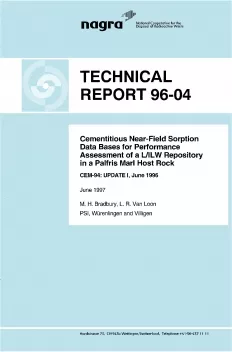
Technical Report NTB 96-04
Cementitious Near-Field Sorption Data Bases for Performance Assessment of a UI L W Repository in a Palfris Marl Host Rock
This report is an update on an earlier cementitious sorption data base (SDB) prepared by BRADBURY & SAROTT (1994). The aim is to review any new information or data which have become available in the intervening time and modify the existing SDB appropriately. Discussions will be confined predominantly to areas which have lead to significant changes to or reappraisals of the data/values or procedures for obtaining/modifying them. From this point of view this update and the previous SDB are closely related and belong together.
The complexation of radionuclides with organic ligands resulting from the chemical degradation of cellulose, and the subsequent negative effects on sorption properties, were identified as being processes of great importance. Since 1994 significant progress has been made in this field and a major part of this work is devoted to a reassessment of the impact of "organics" on nearfield sorption. In particular, the very conservative assumptions which had been made previously because of the general lack of good quality data available at that time, could be replaced by realistic parameter estimates based on new knowledge. For example, maximum likely concentrations of cellulose degradation products and cement additives in the cement pore waters could be calculated allowing the potential effects of these organics ligands on sorption to be bounded.
Sorption values for safety relevant radionuclides corresponding to the three broad stages of cement/concrete degradation during the lifetime of the repository are presented in tabulated form. The influence of the wide variety of organic ligands existing in the different waste catagories, SMA-1 to SMA-4, is quantified in terms of sorption reduction factors.
In the compilation of this cement SDB update, radionuclide uptake onto the vast quantities of aggregate materials (in concretes) and corrosion products from iron/steel (from drums and reactor decommissioning) was not taken into account. A first appraisal of the potential contribution from limestone, quartz and goethite to retention in the near field is given. The aim was not so much to provide quantitative sorption data, but rather to begin the process of integrating these materials into safety assessment considerations.
Finally, some brief comments concerning the recrystallisation of calcium silicate hydrate (CSH) gels, carbonation, colloids and radionuclide incorporation into CSH phases are given.
